Intel Core i7 4960X (Ivy Bridge E) Review
by Anand Lal Shimpi on September 3, 2013 4:10 AM EST- Posted in
- CPUs
- Intel
- Ivy Bridge
- Ivy Bridge-E
Video Transcoding
With our lightly threaded tests behind us, it's time to move to more CPU intensive pastures.
We migrated to the latest verison of the x264 HD benchmark which features a much newer version of x264 and a much heavier workload. The focus here is on quality rather than speed, thus the benchmark uses a 2-pass encode and reports the average frame rate in each pass.
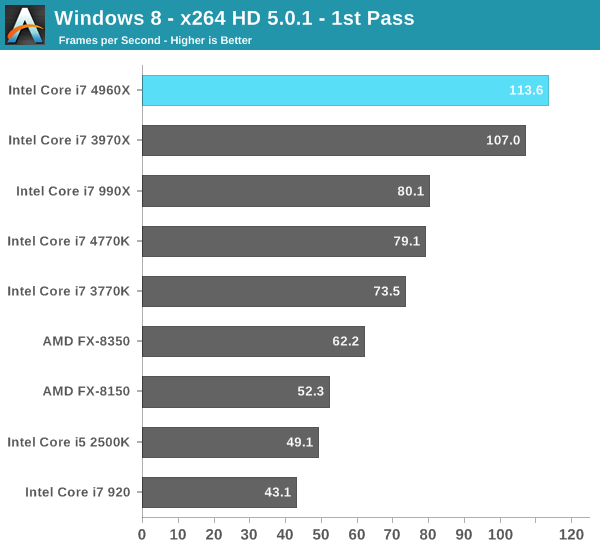

Here we see all of the 6-core parts rise to the top, including Intel's old Gulftown based Core i7-990X. Despite being a few years old at this point, the 990X's 6-core design and relatively high clock speed gives it better performance here than the quad-core Haswell 4770K.
The 4960X manages to be around 30% faster than the old 990X, and is 40% faster than the 4770K. For heavily threaded applications, there's simply no replacement for more cores.
Just like I did earlier, I dusted off one of our really old x264 tests so we'd have comparison data to even older CPUs including the Pentium 4 and Penryn based Extreme Edition parts:
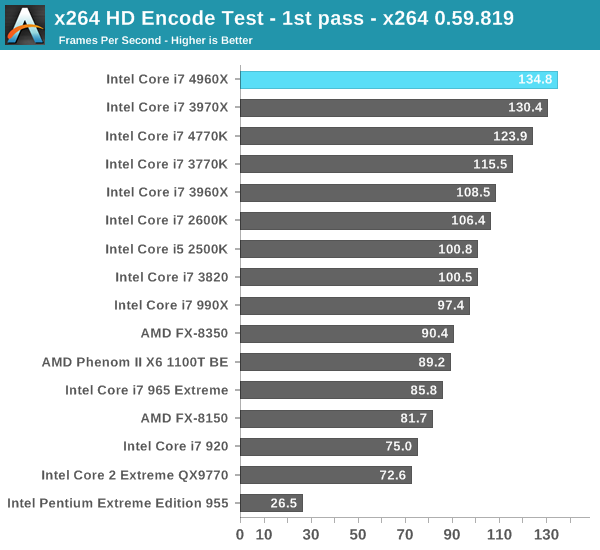
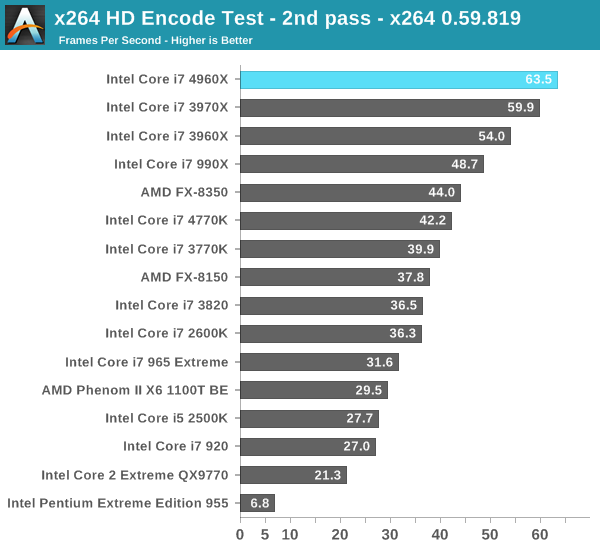
The 4960X manages to deliver nearly 3x the performance of Intel's flagship from 6 years ago. The Pentium EE 955 comparison is even more insane. IVB-E is basically an order of magnitude faster than the last high-end Pentium 4s to come out of Intel back in 2005.
3D Rendering
Our new POV-Ray benchmark uses the latest beta binary (3.7RC6) and runs through both single and multithreaded versions of the popular raytracing benchmark.
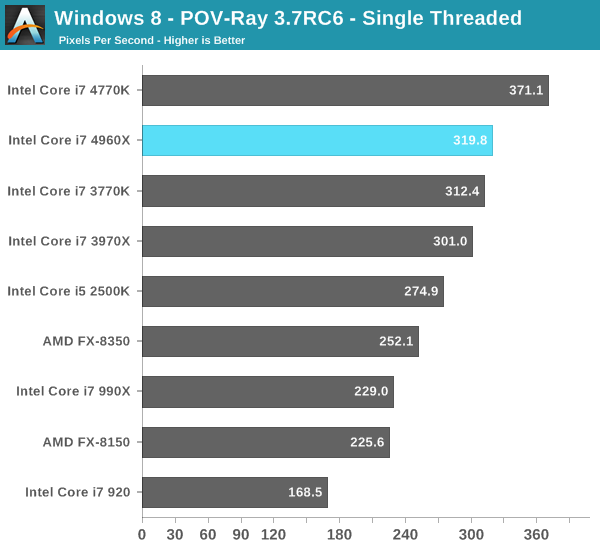
Isolating a single core shows us exactly what we're missing by having Ivy Bridge at the heart of the 4960X instead of Haswell. Here the 4770K manages a 16% performance advantage over the 4960X, which costs 3x as much and draws substantially more power. Looking at AMD's FX-8350 however it's clear why Intel can get away with launching a high-end 6-core chip without its latest cores. Piledriver's single threaded performance falls somewhere between Nehalem and Sandy Bridge, giving Intel room to launch another Ivy Bridge based high-end SKU in 2013 and get away with it.
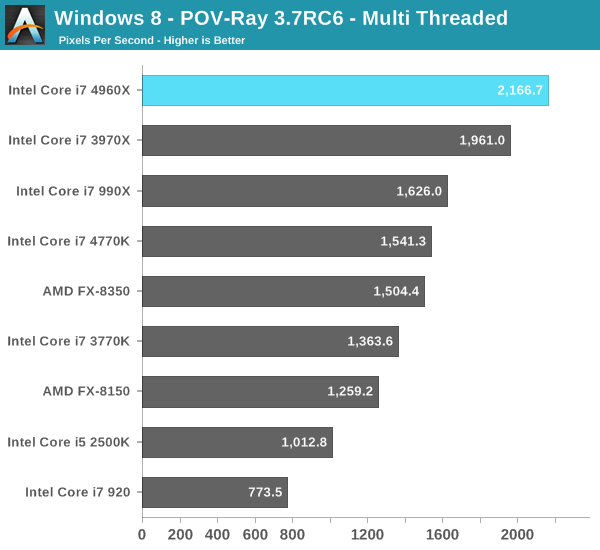
The multithreaded performance story is very different. Here even the Gulftown based 990X is faster than Haswell thanks to its six cores. The 4960X is 40% faster than the Haswell based 4770K. Even AMD's FX-8350 does really well here, basically equalling Haswell's performance.
Created by the Cinema 4D folks we have Cinebench, a popular 3D rendering benchmark that gives us both single and multi-threaded 3D rendering results.
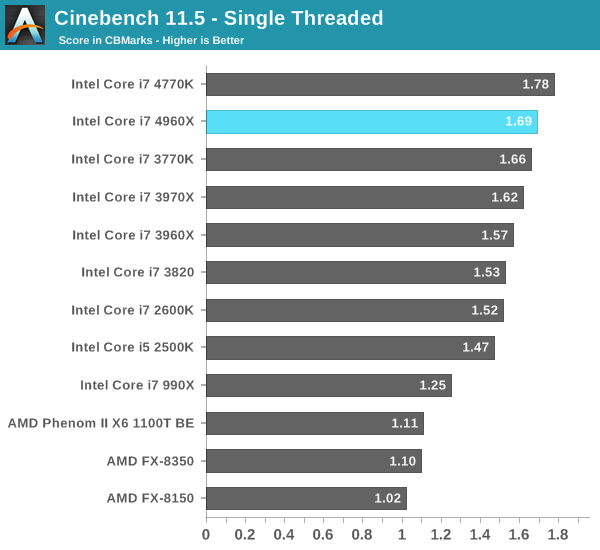
In Cinebench, the single threaded Haswell/IVB-E gap narrows to 5%.
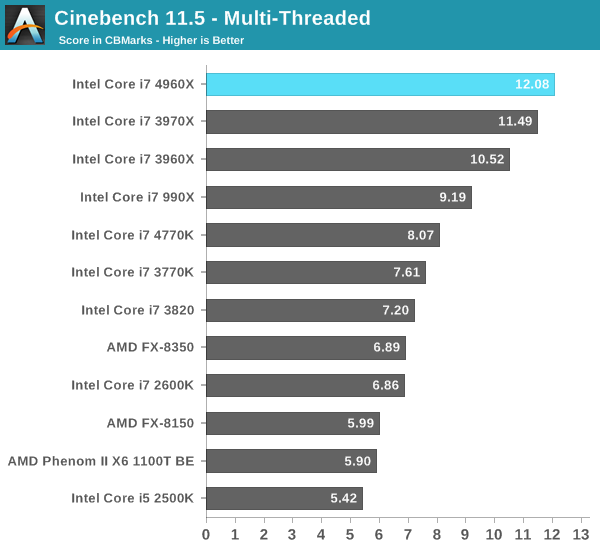
Multithreaded performance continues to be just stellar. Here the 4960X is just under 50% faster than the 4770K. Note the relatively small gap between the 4960X and the SNB-E based 3970X however - the performance gain is only 5%. The bulk of Ivy Bridge's advancements were in GPU performance (not applicable to IVB-E) and power consumption (which we'll get to shortly).
Our final two Cinebench tests use the R10 benchmark to enable a comparison to more/older data points:
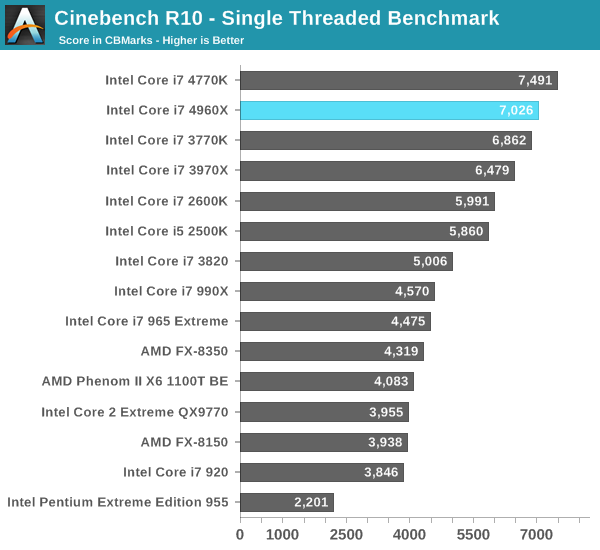
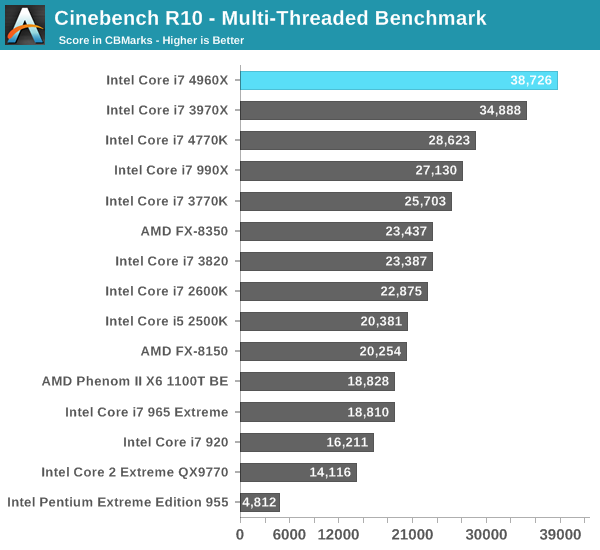










120 Comments
View All Comments
madmilk - Tuesday, September 3, 2013 - link
If you invested in the 980 or the 970 (not the extreme ones) you got an awesome deal. Three years old, $600, overclockable, and within 30% of the 4960X on practically everything.bobbozzo - Tuesday, September 3, 2013 - link
True, but my Haswell i5-4670k was around $200 for the CPU (on sale), and under $150 for an ASUS Z87-Plus motherboard.It's running on air cooling at 4.5/4.5/4.5/4.4GHz.
I wasn't expecting it to be as fast for gaming as an i7-4770k, but looking at the gaming benchmarks in this article, I'm extremely pleased that I did not spend more for the i7.
althaz - Tuesday, September 3, 2013 - link
I had a launch model Core 2 Duo (the E6300) that with overclocking (1.86Ghz => 2.77Ghz) was a pretty decent CPU until last year (when I replaced it with an Ivy Bridge Core i5). That's what? Six years out of the CPU and it's still going strong for my buddy (to whom it now belongs).Kevin G - Tuesday, September 3, 2013 - link
"My biggest complaint about IVB-E isn't that it's bad, it's just that it could be so much more. With a modern chipset, an affordable 6-core variant (and/or a high-end 8-core option) and at least using a current gen architecture, this ultra high-end enthusiast platform could be very compelling."I think that you answered why Intel isn't going this route earlier in the article. Consumers are getting the smaller 6 core Ivy Bridge-E chip. There is also a massive 12 core chip due soon for socket 2011 based servers. Harvesting an 8 core versions from the 12 core die is an expensive proposition and something Intel may not have the volumes for (they're not going to hinder 10 and 12 core capable dies to supply 8 core volumes to consumers). Still, if Intel wanted to, they could release an 8 core Sandy bridge-E chip and use that for their flag ship processor since the architectural differences between Sandy and Ivy Bridge are minor.
The chipset situation just sucks. Intel didn't even have to release a new chipset, they could have released an updated X79 (Z79 perhaps?) that fixed the initial bugs. For example, ship with SAS ports enabled and running at 6 Gbit speeds.
Sabresiberian - Tuesday, September 3, 2013 - link
"The big advantages that IVB-E brings to the table are a ridiculous number of PCIe lanes , a quad-channel memory interface and 2 more cores in its highest end configuration."I'm going to pick on you a little bit here Anand, because I think it is important that we convey an accurate image to Intel about what we as end-users want from the hardware they design. 40 PCIe 3.0 lanes is NOT "ridiculous". In fact, for my purposes I would call it "inadequate". Sure, "my purposes" are running 3 2560x1440 screens @ 120Hz and that isn't the average rig today, but I want to suggest it isn't far off what people are now asking for. We should be encouraging Intel to give us more PCIe connectivity, not implying we have too much already. :)
canthearu - Tuesday, September 3, 2013 - link
Actually, you would find that you are still badly limited by graphics power, rather than limited by system bandwidth.A modern graphics card doesn't even stress out 8 lanes PCIe 3.0.
I'm also not saying that it is a bad thing to have lots of I/O, It isn't. However you do need to know where your bottlenecks are. Otherwise you spend money trying to fix the wrong thing.
The Melon - Tuesday, September 3, 2013 - link
Not all high bandwidth PCI-e cards are graphics cards.I for one would like to be able to run 2x PCIe x16 GPU's and at least 1 each of LSI SAS 2008, dual port DDR or QDR Infiniband, dual port 10GBe and perhaps an actual RAID card.
Sure that is a somewhat extreme example. But you can only run one of the expansion cards plus 2 GPU before you run out of lanes. This is an enthusiast platform after all. Many of us are going to want to do Extreme things with it.
Flunk - Tuesday, September 3, 2013 - link
Now you're just being silly, sending $10,000 on a system without any real increase in performance for anything you're going to do on a desktop/workstation is just stupid.Besides, if you're being incredibly stupid you'd need to go quad Xeons anyway (160 PCI-E lanes FTW).
Azethoth - Tuesday, September 3, 2013 - link
On the one hand, good review. On the other hand, my dream of a new build in the "performance" line is snuffed out. It just seems so lame making all these compromises vs Haswell, and basically things will never get better because the platform target is shifting to mobile and so battery life is key and performance parts will just never be a focus again.f0d - Tuesday, September 3, 2013 - link
i feel the same waythe future doesnt look too bright for the performance enthusiast - i dont want low power smaller cpu's i want BIG 8/12 core cpus and i dont really give a crap about power usage